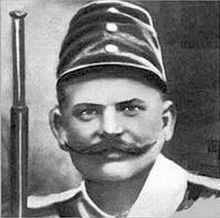Béla Kiss
| Béla Kiss | |
|---|---|
 Sketch of Béla Kiss | |
| Born |
c.1877 Hungary |
Cause of death | Unknown |
| Conviction(s) | Never convicted |
| Killings | |
| Victims | 24+ |
Span of killings | 1900–1914 |
| Country | Hungary |
Date apprehended | Never apprehended |
Béla Kiss (1877 – ?)(last name pronounced "Kish") was a Hungarian serial killer. He is thought to have murdered at least 24 young women and attempted to pickle them in giant metal drums that he kept on his property.
Life
Béla Kiss was a tinsmith who had lived in Czinkota (then a town near Budapest, now a neighborhood within the city itself) since 1900. He was an amateur astrologer and allegedly fond of other occult practices. In 1912 Kiss hired a housekeeper, Mrs. Jakubec, and began to correspond with a number of women and sometimes took them to his home in Czinkota. However, his housekeeper never really got to know any of them and Kiss was never on intimate terms with his neighbors even though he was well-liked.[1]
Townsfolk also noticed that Kiss had collected a number of metal drums. He had told the town police who questioned him that he filled them with gasoline in order to prepare for the rationing of the oncoming war. When World War I began in 1914, he was conscripted and left his house in Jakubec's care.
Search
In July 1916, Budapest police received a call from a Czinkota landlord who had found seven large metal drums. The town constable had remembered Kiss' stockpile of gasoline, and led needy soldiers to them. Upon attempting to open the drums, a suspicious odour was noted. Detective Chief Charles Nagy took over the investigation and opened one of the drums, against the protests of Mrs. Jakubec. There they discovered the body of a strangled woman. The other drums yielded similarly gruesome content. A search of Kiss' house resulted in a total of 24 bodies.[1]
Nagy informed the military that they should arrest Béla Kiss immediately, if he was still alive - there was also a possibility that he was a prisoner of war. The name, unfortunately, was very common. Nagy also arrested the housekeeper, Mrs Jakubec and asked the postal service to hold any possible letters to Kiss, in case he had an accomplice that could warn him. Nagy initially suspected that Jakubec might have had something to do with the murders, especially when Kiss had left her money in his will.
Jakubec assured police that she knew absolutely nothing about the murders. She showed them a secret room Kiss had told her never to enter. The room was filled with bookcases but also had a desk that held a number of letters, Kiss' correspondence with 74 women and a photo album. Many of the books were about poisons or strangulation.
From the letters Nagy discerned several things. The oldest of the letters were from 1903 and it became clear that Kiss was defrauding the women who had been looking for marriage.[1] He had placed ads in the marriage columns of several newspapers and had selected mainly women who had no relatives living nearby and knew no one who would quickly notice their disappearance. He wooed them and convinced them to send him money. Police also found old court records that indicated that two of his victims had initiated court proceedings because he had taken money from them. Both women had disappeared and the case had been dismissed.
Each woman that came to the house was strangled. Kiss then pickled their bodies in alcohol and sealed them in the metal drums. Police found that the bodies had puncture marks on their necks and their bodies were drained of blood. This led them to believe that Kiss was some kind of vampire.[1]
Escape
On October 4, 1916 Nagy received a letter that stated that Kiss was recuperating in a Serbian hospital. Nagy arrived too late — Kiss had fled and substituted a dead body of another soldier in his bed. Nagy alerted all the Hungarian police. However, all the sightings police could check proved to be wrong.
On several later occasions, speculation arose that Kiss had perhaps faked his death by exchanging identities with a dead soldier during the war. He was supposedly sighted numerous times in following years and there were various rumors about his fate, including that he had been imprisoned for burglary in Romania or he had died of yellow fever in Turkey.
Sightings
In 1920 a soldier in the French Foreign Legion reported on another legionnaire named Hoffman (the name Kiss had used in some letters) who had boasted how good he was at using a garrote, and who fit Kiss' description. "Hoffman" deserted before police could reach him.[1]
In 1932, homicide detective Henry Oswald was certain he had seen Kiss coming out of Times Square Subway in New York City. There were also rumors that Kiss was living in the city and working as a janitor but they could not be verified. When the police went to interview the janitor, the janitor had already gone.
Kiss' eventual fate and exact number of victims remains unknown.[1]
In popular culture
- The play 23 by Antonin Artaud was inspired by the case.
- The German horror movie Bela Kiss: Prologue by director Lucien Förstner released in 2013 is based on Kiss’ biography.